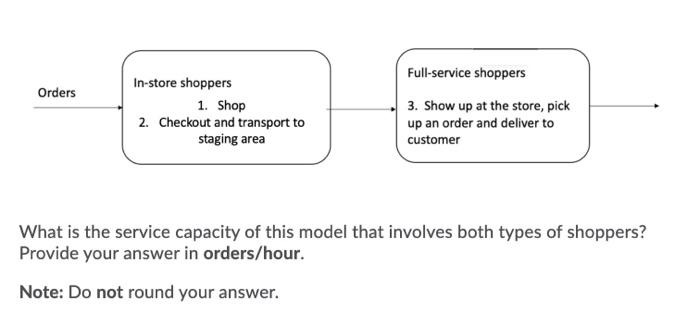In this question and the next question, let us study model II in Figure 1, under which an order is fulfilled by both an in-store shopper and a full-service shopper. We will assume that all orders are fulfilled in this way. In-store shoppers: Suppose that they operate as in Question 2 (i.e., they will check out one order at a time, instead of batching up two orders). On average, it takes 25 minutes on average for a shopper to pick all items on the list, and 15 minutes to check out the items and move them to the staging area. Full-service shoppers: Suppose that full-service shoppers focus on delivery of orders (they don't do any in-store shopping at the Walmart supercentre). There is a relatively large pool of full-service shoppers who delivers for many grocers in the city. If the Walmart supercentre keeps requesting full-service drivers to pick up order from the staging area, the maximum frequency of those shoppers arrive at the store is 3 visits/hour. Suppose that they will pick up one order in each visit. The collaboration by the two types of shoppers are demonstrated in the following diagram. For simplicity, assume that there is only 1 in-store shopper. Orders In-store shoppers 1. Shop 2. Checkout and transport to staging area Full-service shoppers 3. Show up at the store, pick up an order and deliver to customer What is the service capacity of this model that involves both types of shoppers? Provide your answer in orders/hour. Note: Do not round your answer. In this question and the next question, let us study model II in Figure 1, under which an order is fulfilled by both an in-store shopper and a full-service shopper. We will assume that all orders are fulfilled in this way. In-store shoppers: Suppose that they operate as in Question 2 (i.e., they will check out one order at a time, instead of batching up two orders). On average, it takes 25 minutes on average for a shopper to pick all items on the list, and 15 minutes to check out the items and move them to the staging area. Full-service shoppers: Suppose that full-service shoppers focus on delivery of orders (they don't do any in-store shopping at the Walmart supercentre). There is a relatively large pool of full-service shoppers who delivers for many grocers in the city. If the Walmart supercentre keeps requesting full-service drivers to pick up order from the staging area, the maximum frequency of those shoppers arrive at the store is 3 visits/hour. Suppose that they will pick up one order in each visit. The collaboration by the two types of shoppers are demonstrated in the following diagram. For simplicity, assume that there is only 1 in-store shopper. Orders In-store shoppers 1. Shop 2. Checkout and transport to staging area Full-service shoppers 3. Show up at the store, pick up an order and deliver to customer What is the service capacity of this model that involves both types of shoppers? Provide your answer in orders/hour. Note: Do not round your








